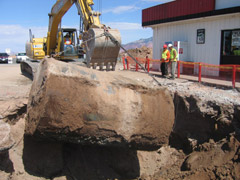Contact Pacific Southwest Waste Program
Pacific Southwest, Region 9
Serving: Arizona, California, Hawaii, Nevada, Pacific Islands, Tribal Nations
Leaking Underground Storage Tanks in Indian Country
The Issue
Underground Storage Tanks (USTs) are most frequently found storing fuel at gas stations. The fuel can leak and contaminate soil and nearby sources of drinking water.

Removal of an underground storage tank
Leaking underground storage tanks (LUSTs) are a threat to the environment and health because the product (usually petroleum) stored in them can contaminate soil and spread to groundwater and surface water. 12 ounces of gasoline (the volume of a can of soda) can contaminate approximately 40,000 gallons of water.
Exposure to petroleum, either through the water or through vapors that rise from the contaminated soil, is harmful to human health. Benzene, a main component of gasoline, is a known carcinogen. Other gasoline components can also be very harmful to human health and the environment.
Once a UST is confirmed to be leaking, cleanup activities and durations can vary widely depending on the degree of contamination at the site. The simplest sites require only removal of the tank system and sampling of the soil to ensure that it is not contaminated. The large-scale cases on the other end of the spectrum can require several years of remediation and may cost over $1 million.
Frequently Used Terms
Preliminary investigation - A site investigation that does not include excavation activities. Such an investigation may involve surveying sites with ground penetrating metal detectors, reviewing records for historical information about the USTs, and identifying nearby receptors (e.g. drinking water wells and communities) that may be affected if the tank is leaking.
Cleanup - The entire process of addressing a leaking or potentially leaking UST site, starting with site assessment and ending with closure.
Site assessment - An investigation of the site to determine presence of contamination. The process can involves removing the tank, excavating soil, taking samples of soil and (if encountered) groundwater, and analyzing the samples. If the site assessment finds no contamination threatening human health and environment, the site can be closed upon completion of the assessment. If contamination is found, remediation is required.
Remediation - The implementation of an engineered system to actively remove the contamination from soil and/or groundwater.
Site closure - A process that closes a site when it no longer poses a threat to human health and the environment. Closure is complete after environmental data indicates that the site no longer contains contamination that poses a risk to human health and the environment.
